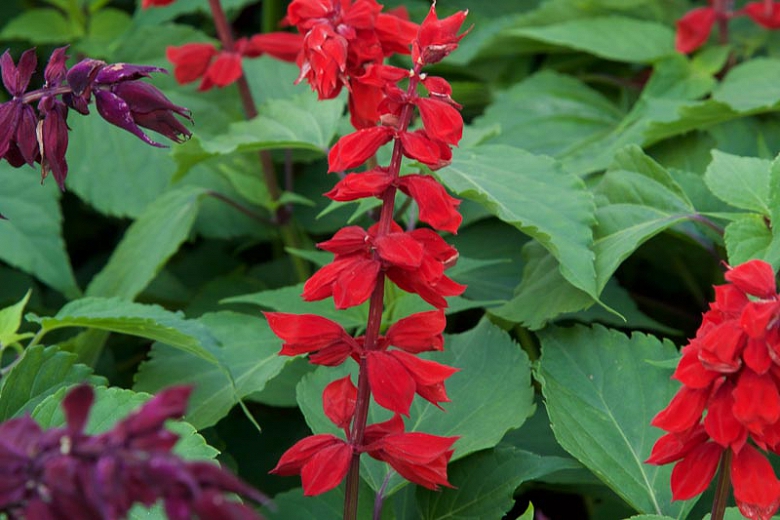Red salvia is a great addition to your garden because it can be used for borders, containers or even as an annual plant in the ground. It’s also called scarlet sage. Salvias are members of the mint family and are grown as a perennial plant but are often grown as an annual in temperature zones.
Even though the scarlet variety is best known, salvia splendens comes in other colors: white, purple, lavender, salmon, pink, burgundy, and orange. With its dark green and heart-shaped leaves, this plant emits a fragrance that mammals don’t like, making it deer and rabbit resistant.
We’ve created this guide that will teach you all about red salvia growing tips and tricks. You’ll learn everything you need to know, including soil requirements, light needs and more.
Caring for Red Salvia
If you’re looking for a plant that can add fragrance to your garden, then red salvia is the best choice. To improve the look of this perennial salvia and encourage it to produce continuous blooms, it’s wise to deadhead faded blooms. You can do this by pinching flower spikes and removing the spent blooms.

Image credit: https://www.thespruce.com/
Salvia plants are easy to care for and are drought-tolerant; they can survive on natural rainfall. This reduces the need for you to water them during dry spells and will save you money too. Here are some of the caring tips to consider:
Light
Make sure that you choose a bright, sunny position for your salvia plants. They require at least four hours of sun every day to thrive. They can also grow successfully in areas with partial shade. However, full sun will provide them with their preferred conditions.
Water
Red salvia plants like moist soil, but consistent watering can cause root rot. Watering can be done every seven to ten days, depending on the rainfall amounts and hot daytime temperatures. Before watering, make sure the first inch or two of the soil is dry. If the soil is dry, you can water the plant until it flows to the plant roots.
Salvia plants are drought tolerant plants, but they do best with consistent watering. They will tolerate dry soil once in a while if their water needs are met. So, make sure you keep the soil moist to help it thrive.
Soil
Plant your scarlet sage in soil that drains well. Soil with a high organic content is preferred. If nutrient deficiencies become a problem, it’s likely due to soil issues. Be cautious about adding any fertilizers as they may burn the roots of the plant. Cultivate the soil approximately four inches down with a garden spade. After that, sprinkle the compost on the top then work down again with a garden spade. Learn how to make a compost bin to make this easier.
Make sure you plant your salvia in well-drained soil to discourage root rot. Mulching around the plant to a depth of 2 inches will help it retain water. So, apply a 2-inch thick layer of bark or wood chip mulch on top of the compost to help it soil moisture and control weeds.
Use a test home kit to test the soil pH in a site with good soil drainage and full sun in cool summer climates and partial sun. If the pH is high, add in organic compost because poor or high pH can lead to alkalinity which this plant hates. You can also plant your red salvia in containers filled with potting soil. Add the potting mix to cover the roots firmly.
Plant the Seedling
Water the red salvia seeds. Water thoroughly so that water comes out through the bottom of the container. For container-grown plants, place containers in trays filled with damp pebbles, so they don’t dry out between watering. Make sure you fill your container with standard potting soil.
As you pop your red salvia seedling out of its cell or pot, ensure you maintain the soil mix around the root ball. Place it on the hole so that the root ball can be on the same level with the soil surface. Mulch around your red salvia to retain soil moisture and control weeds, especially if you planted it in a garden bed.
dd Fertilizer
Add a granular fertilizer high in phosphorus when the red salvia has been in the ground for six weeks. Phosphorus promotes blooming and reduces flower bud drop. Look for fertilizers with 7-8 percent nitrogen.
You can also use the same balanced fertilizer you use to fertilize your other annual flowering plants. Red salvia will do fine with one springtime fertilization.
Temperature and Humidity
Red salvia requires a long growing season, and it’s best to start seeds indoors and transplant outdoors when the danger of frost is past. Once your red salvia has finished blooming, cut the dead flowers off close to the stem. If you shear back too far, you’ll get new growth that will flower later in summer or fall.
Do not subject them to prolonged temperatures below 32 degrees Fahrenheit. If you’re bringing them indoors for the winter, keep them in a cool room and avoid drafts from air conditioners or fans. When it comes to humidity, red salvia doesn’t have any special humidity needs.
Salvia Varieties
You can buy many cultivars of salvia at the garden center and online. While they have the same requirements, they’ll vary in color, height, etc. For example, the scarlet variety has bright red flowers while “Victoria” has pink ones.

Image credit: https://www.gardenia.net/
The list below are some popular medicinal varieties of salvia that are also beautiful to look at:
lba
This is a salvia variety with white flower spikes and grey-green leaves. It’s also the tallest variety, growing to around 3 feet tall.
Salsa Scarlet Bicolor
This unique variety features bicolored red and white flower spikes that fade to pink as the flowers mature. It’s a short variety, typically growing about 2 feet tall.
Carabiniere
This is a compact variety with red flower spikes that grows to 14 inches.
blazin Purple
This variety produces royal purple flower spikes and can grow to 26 inches tall.
Peruvian Sage
The flowers of this sage are dark purple and have grey-green leaves on top and white leaves underneath.
utumn Sage
This is a drought-tolerant sage with brilliant colors that blooms through the summer and into the fall.
zure Sage
This variety has aromatic foliage and sky blue flowers in the late fall.
Hybrid Sage
These perennial varieties are perfect for colder areas. They’re 24 inches tall and bloom in late spring to early summer.
Red Salvia Pests and Diseases
Monitor salvia plants for slugs, whiteflies, spider mites, thrips and aphids. Slugs are the only known salvia pest that’s difficult to control. Salvia Root Disease is caused by a fungus called fusarium. It can be prevented by good drainage and air circulation around the plant. Also, do not over-fertilize or use fertilizer pellets for the growth of salvia spp.

Image credit: https://www.almanac.com/
FAQs on How to Grow Scarlet Sage
Does red salvia self-seed?
Yes, salvia splendens grow as a self-seeding annual.
Do salvias come back every year?
Salvias are considered annuals because they’re expected to overwinter only in warm climates. They’re typically planted in the spring and compost in late fall.
Final Thought on How to Grow Red Salvia
There you go! Growing red salvia is easy if you have the right tools and information. With minimal care, these bright flowers can dress up your flower garden throughout the growing season.
The post How to Grow Red Salvia appeared first on Kitchen Infinity.
Did you miss our previous article…
https://chefbuano.com/?p=542